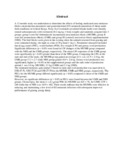Effects of medicated urea-molasses block supplementation on productivity and gastrointestinal nematode infections of sheep in Nyandarua District, Kenya

View/
Date
2012Author
Waruiru, R.M
Munyua, W.K
Otieno, R.O
Mutune, M.N
Gichohi, V.M
Gitari, R.N
Metadata
Show full item recordAbstract
A 13 months study was undertaken to determine the effects of feeding medicated urea-molasses blocks on production parameters and gastrointestinal (GI) nematode parasitism of sheep under field conditions in Central Kenya. Forty-five Corriedale crossbred female lambs were initially treated subcutaneously with ivermectin (0.2 mg kg-1 body weight) and randomly assigned into 3 groups: group I were fed fenbendazole incorporated urea-molasses blocks (MUMB), group II were fed ureamolasses blocks (UMB) and group III (control) received no block supplementation (NBS). The feed blocks were given in the evening when the animals returned from grazing and were consumed during the night at a rate of 30 g head-1 day-1. Parameters measured included faecal egg counts (FEC), worm burdens (WB), live-weight (LW) and greasy wool production. Significant differences (p < 0.05) were found in LW changes of the MUMB group compared with the NBS and the UMB groups, respectively. The mean LW responses of the UMB group were significantly (p < 0.05) greater than those of the NBS group. Comparing the LWs at the start and end of the study, the MUMB group gained an average of (+ s.d.) 21.9 + 2.4 kg, the UMB group 17.3 + 2.7 while NBS group gained 10.9 + 2.6 kg. Greasy wool production was significantly higher (p < 0.05) in the supplemented groups and the rank order of production animal-1 was 3.6 kg (MUMB), 3.3 kg (UMB) and 2.1 kg (NBS).
The estimated monetary gain animal-1 based on meat and wool production was equivalent to US$ 47.51, US$ 37.26 and US$ 27.59 for the MUMB, UMB and NBS groups, respectively. The FECs for the MUMB group differed significantly (p < 0.05) compared to those of the UMB and NBS groups.
However, no significant differences (p > 0.05) in FECs were found between the UMB and NBS
groups. On necropsy, the mean (+ s.d.) group WBs for MUMB was 425 + 76, for UMB 1279 + 240 while that of NBS was 1619 + 402. These results indicate that the MUMBs were effective in reducing and maintaining a low level of GI nematode infection with subsequent improved performance of grazing young sheep.
